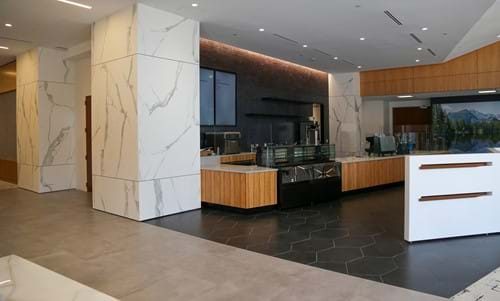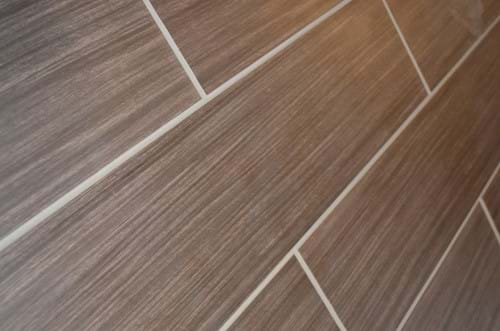Top 10 Myths about Large Format Tile Installations

No longer do 12-inch square tiles reign over the tile world. Common tile sizes have been increasing, and now 12-inch by 24-inch tiles or the 48-inch-long planks are now normal. The misconception is that these larger tile sizes do not affect the methods or equipment needed for the installation. Large format tiles require a bit more planning ahead due to their size.
Read our top ten myths below to learn some tips and best practices.
- Large format tiles are only the really big ones, like 24”x 48”.
- Large format tiles include all tiles with at least one edge over 15”. The 6” x 48” wood-look plank tiles are considered large format! A large format tile (LFT) mortar should be used to ensure proper coverage.

- Since more mortar is being used, the substrate doesn’t need to be that flat.
- The ANSI (American National Standards Institute) requires a flatter surface for large format tiles than smaller tiles. The flatness requirements for these large format tiles are the substrate should not vary more than 1/8” in ten feet and not more than 1/16” in 24 inches. Patches or self-levelers, like Level Set 500 HF, can aid in achieving this flatness.
- If the large format tile mortar works on a floor, it will work on a wall too.
- Not all mortars have non-slip properties for walls and non-slump properties for floors. It is important to know if the mortar is acceptable for the installation. For example, Ultimate 6 Plus can be used for both floor and wall applications with LFT.
- The trusty ¼”x ¼” square notch trowel will work just fine.
- There is not a one-size-fits-all guideline for trowels for LFT applications, but 80-100% coverage should be achieved depending on installation area and tile type. A ¼”x ¼” square notch trowel will not achieve adequate coverage for LFT. Consider trowels like ½”x ½” square notch, the Euro trowel, or the slant notch trowel to reach 80%+ coverage.
- For the best look, the large format tiles should be offset 50%.
- If tiles are offset by 50%, the highest part of one tile will be next to the lowest part of the next potentially causing a trip hazard. TCNA (Tile Council of North America) recommends a maximum of 33% offset for large format tiles.
- Spot bonding is the best way to stick these tiles to the wall and saves money on mortar too.
- Spot bonding does not provide coverage close to 80% requirement. Spot bonding can lead to cracked floor tiles, shadowing of the mortar through the tile or stone and potential for other failures.
- Moisture mitigation is a waste of money with all tile installations.
- High moisture in the slab coupled with fewer grout joints for the moisture to escape increases the chance of efflorescence. Moisture mitigation below the tile installation can protect the installation from the moisture in the concrete.
- Because the tiles are bigger, the installation will go faster.
- While less tiles are being set, the preparation work before the tiles are laid takes quite a bit of time. Adequate surface preparation, cuts to accommodate plumbing, transportation of the tiles, back-buttering, and additional care to set the tiles in place takes additional time. Make sure to account for this additional labor in the bid.
- Special equipment is never needed.
- When working with large format tiles, especially gauged porcelain panels, additional equipment is needed. Angle grinders to cut around plumbing, sturdy tables to support the tiles, suction cups to lift the panels, and a system of leveling clips are needed for gauged porcelain panel installations.

- All large format tiles are the same.
- Large format tiles encompass quite a few tile types including large format natural stone and gauged porcelain panels which each pose their own challenges. Before selecting a mortar for the installation, be sure to know exactly what type of tile is being installed.
Large format tiles continue to grow in popularity and setting these tiles doesn’t have to be intimidating. Using the right mortar and tools with proper planning and techniques, the installation will be a success. To learn more about installing large format tiles, see our AIA approved continuing education course: Large Format Wall and Floor Tile: Design Challenges and Solutions.
